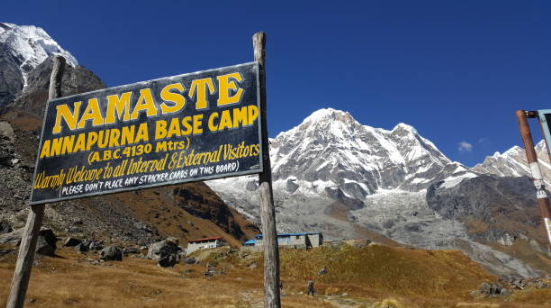The Annapurna Base Camp Trek is one of the most popular and rewarding treks in Nepal, attracting trekkers from around the world with its breathtaking views, diverse landscapes, and cultural richness. Located in the heart of the Annapurna Conservation Area, the trek takes adventurers through lush forests, terraced fields, and traditional Gurung villages before reaching the stunning Annapurna Base Camp (ABC) at 4,130 meters. This trek is a perfect blend of natural beauty, cultural exploration, and high-altitude adventure, offering a challenging yet accessible experience for trekkers of various levels.
Trekking Overview
The Annapurna Base Camp Trekking starts from Nayapul, a short drive from the city of Pokhara, and winds through a series of picturesque villages such as Tikhedhunga, Ghorepani, Poon Hill, and Chhomrong. Along the way, trekkers pass through subtropical forests of rhododendron, oak, and bamboo, providing an excellent opportunity for nature lovers and birdwatchers. The trek offers panoramic views of several of the world’s highest peaks, including Annapurna I, Annapurna South, Machapuchare (Fishtail), and Hiunchuli, creating a truly awe-inspiring experience.
The journey to Annapurna Base Camp is moderate in difficulty, with a well-marked trail that gradually ascends over several days, providing trekkers ample time to acclimatize to the increasing altitude. This gradual ascent reduces the risks of altitude sickness, making it suitable for trekkers with a moderate level of fitness. The trek typically takes 7-10 days to complete, depending on the pace and the chosen route, and is best undertaken during the spring (March to May) or autumn (September to November) seasons, when the weather is most favorable.
Highlights of the Trek
- Poon Hill Sunrise Viewpoint
One of the early highlights of the Annapurna Base Camp Trek is the hike to Poon Hill. Situated at an altitude of 3,210 meters, Poon Hill offers one of the most iconic sunrise views in Nepal. As the sun rises over the horizon, the snow-capped peaks of the Annapurna and Dhaulagiri ranges light up in shades of pink, orange, and gold, offering trekkers an unforgettable sight.
- Diverse Landscapes and Villages
As the trek progresses, trekkers pass through a variety of landscapes, from lush subtropical forests in the lower altitudes to alpine meadows and barren terrain near the base camp. The trek also takes trekkers through culturally rich villages like Ghorepani, Chhomrong, and Bamboo, where the local Gurung and Magar communities maintain traditional ways of life. These villages provide trekkers with an opportunity to experience authentic Nepali hospitality and gain insights into the rich culture and traditions of the region.
- Annapurna Base Camp
The ultimate destination of the trek is Annapurna Base Camp, which sits at 4,130 meters and offers stunning 360-degree views of the surrounding peaks. The view from ABC Trekking is truly spectacular, with the towering Annapurna I and Machapuchare (Fishtail) dominating the skyline. At ABC, trekkers feel an incredible sense of achievement as they stand at the foot of these majestic mountains, surrounded by glaciers and deep valleys.
Flora and Fauna
The Annapurna Conservation Area, through which the trek passes, is home to an incredible diversity of flora and fauna. The lower altitudes are rich in dense forests, which are home to species like the red panda, Himalayan tahr, and langur monkeys. The region also supports a variety of bird species, including the Himalayan griffon vulture and various types of pheasants. As trekkers ascend to higher altitudes, the flora transitions from dense forests to alpine meadows and rocky terrain.
Difficulty and Preparation
The Annapurna Base Camp Trek is considered a moderate trek, suitable for trekkers with a good level of fitness and previous trekking experience. Although the maximum altitude of 4,130 meters is lower than other high-altitude treks like Everest, trekkers should still be mindful of altitude sickness and take precautions. Adequate acclimatization, staying hydrated, and proper pacing are essential for a safe and enjoyable trek. The trail itself is well-maintained, but the terrain can be rugged, and some days may involve steep ascents and descents.
Conclusion
The Annapurna Base Camp Trek is an incredible journey that offers a unique blend of natural beauty, cultural immersion, and physical challenge. From the panoramic views of the Annapurna range to the rich cultural experiences in local villages, this trek is one of Nepal’s most rewarding. Whether you are an experienced trekker or a first-time adventurer, the Annapurna Base Camp Trek offers something for everyone, making it an unforgettable experience in one of the world’s most stunning mountain ranges.
